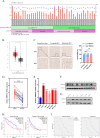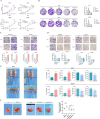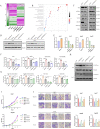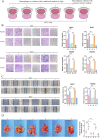TMEM147 aggravates the progression of HCC by modulating cholesterol homeostasis, suppressing ferroptosis, and promoting the M2 polarization of tumor-associated macrophages
- PMID: 37891677
- PMCID: PMC10612308
- DOI: 10.1186/s13046-023-02865-0
TMEM147 aggravates the progression of HCC by modulating cholesterol homeostasis, suppressing ferroptosis, and promoting the M2 polarization of tumor-associated macrophages
Abstract
Background: The endoplasmic reticulum (ER) regulates critical processes, including lipid synthesis, which are affected by transmembrane proteins localized in the ER membrane. One such protein, transmembrane protein 147 (TMEM147), has recently been implicated for its role in hepatocellular carcinoma (HCC) tumorigenesis; however, the mechanisms remain unclear. We investigated the role of TMEM147 in HCC and the underlying mechanisms.
Methods: TMEM147 expression was examined in human HCC cells and adjacent non-tumorous tissues using quantitative reverse transcription-polymerase chain reaction, western blotting, and immunohistochemistry. In vitro and in vivo studies were conducted to investigate the impact of TMEM147 on the progression of HCC. Proteins interacting with TMEM147 were identified via RNA-seq, immunoprecipitation, and mass spectrometry analyses. Lipidomic analysis and enzyme-linked immunosorbent assay (ELISA) were employed to determine and analyze cholesterol and 27-hydroxycholesterol (27HC) contents. Extensive experimental techniques were used to study ferroptosis in HCC cells. The fatty acid content of macrophages affected by TMEM147 was quantified using ELISA. Macrophage phenotypes were determined using immunofluorescence assay and flow cytometric analysis.
Results: TMEM147 mRNA and protein levels were increased in HCC cells, and the increased TMEM147 expression was associated with a poor survival. TMEM147 promoted tumor cell proliferation and metastases in vitro and in vivo. The protein was found to interact with the key enzyme 7-dehydrocholesterol reductase (DHCR7), which affected cellular cholesterol homeostasis and increased the extracellular levels of 27HC in HCC cells. TMEM147 also promoted the expression of DHCR7 by enhancing the activity of signal transducer and activator of transcription 2. 27HC expression upregulated glutathione peroxidase 4 in HCC, leading to ferroptosis resistance and promotion of HCC proliferation. HCC cell-derived 27HC expression increased the lipid metabolism in macrophages and activated peroxisome proliferator-activated receptor-γ signaling, thereby activating M2 macrophage polarization and promoting HCC cell invasion and migration.
Conclusions: Our results indicate that TMEM147 confers ferroptosis resistance and M2 macrophage polarization, which are primarily dependent on the upregulation of cellular cholesterol homeostasis and 27HC secretion, leading to cancer growth and metastasis. These findings suggest that the TMEM147/STAT2/DHCR7/27HC axis in the tumor microenvironment may serve as a promising therapeutic target for HCC.
Keywords: Cholesterol metabolites; Ferroptosis; Hepatocellular carcinoma; TMEM147; Tumor-associated macrophages.
© 2023. The Author(s).
Conflict of interest statement
The authors declare no competing interests.
Figures







References
-
- Hepatocellular carcinoma [J] Journal. 2021;7(Issue):7.
MeSH terms
Grants and funding
- CXPJJH12-2020023/Chen Xiao-Ping Foundation For The Development Of Science And Technology Of Hubei Province
- 2021Y06/Excellent Young Medical Talents Training Fund of the First Affiliated Hospital of Harbin Medical University
- LBH-Q18089/Heilongjiang Provincial Postdoctoral Science Foundation
- UNPYSCT-2018070/The University Nursing Program for Young Scholars with Creative Talents in Heilongjiang Province
- CXPJJH12-2021029/Chen Xiao-Ping Foundation For The Development Of Science And Technology Of Hubei Province
LinkOut - more resources
Full Text Sources
Medical
Miscellaneous

